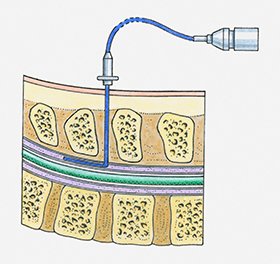Types of Anesthesia




General Anesthesia
Most major surgeries are performed using general anesthesia. This type of anesthesia usually involves a mixture of intravenous and inhaled medications to keep you asleep without awareness during your procedure. It is tailored to you specifically with special attention given to your age, type of surgery, and your co existing medical conditions. At the end of your surgery the medicine is discontinued to allow you to wake up and begin your recovery.
Regional Anesthesia
Regional anesthesia involves numbing the portion of your body that will be operated on. This involves administering local anesthetic (such as lidocaine) to specific nerves to block pain impulses from reaching your brain so that you may remain comfortable during your procedure.
Spinal Anesthesia
Spinal Anesthesia involves injecting local anesthetic into your spinal canal (lower back) with a tiny needle to eliminate pain during your surgery. This type of anesthesia is commonly used for C-sections.
Epidural Anesthesia
Epidural anesthesia is similar to spinal anesthesia in that it involves an injection in your lower back. However in this case a small straw like catheter is placed to continuously give you pain medicine. This is very commonly used during labor to minimize the pain of childbirth.
Interscalene Block
This type of anesthesia is usually used as an adjuvant to general anesthesia during shoulder surgery. An Interscalene block involves injecting local anesthetic medicine around a cluster of nerves that provide sensation and movement to your shoulder. It is usually performed just prior to your surgery, and to keep you comfortable during this “block” we will usually administer a sedative. The benefits include pain relief as long as 16 hours after your surgery and it may allow you to need less intravenous pain medicine during your procedure.
Femoral Nerve Block
Femoral nerve blocks are usually used for certain types of knee surgery such as total knee replacements. In this case local anesthesia medicine is injected in your groin while you are sedated. This “block” provides pain relief for up to 16 hours with a single injection. In most cases we will even place a small catheter in the area to allow for a continuous infusion to give you even longer pain relief.
Sedation Anesthesia
Sedation Anesthesia, sometimes called twilight anesthesia, provides excellent anesthesia for some minor procedures such as breast biopsies. In this case the surgeon may give local anesthetic to the area that he is operating on and the anesthesia provider will give intravenous sedatives needed to keep you awake but very relaxed and minimal chance of awareness in most cases. This type of Anesthesia allows for an easy and speedy awakening and sometimes less side effects.
